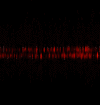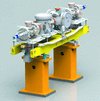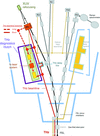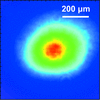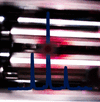issue contents
X-ray Free-Electron Lasers special issue
Edited by P. H. Fuoss, I. Schlichting, T. Tschentscher and M. Yabashi
This virtual issue of Journal of Synchrotron Radiation on X-ray free-electron lasers collects together articles originally published in the journal between March and September 2019.

Cover illustration: Schematic drawing of the reaction microscope at FLASH2. Courtesy of Schmid et al. [J. Synchrotron Rad. (2019). 26, 854–867].
facility information
Free 

A virtual special issue of Journal of Synchrotron Radiation advances in the field of X-ray free-electron lasers.
PAL-XFEL facilitating the 3-BC scheme has achieved reliable XFEL operation with unprecedented stability. Its outperformance over the 2-BC scheme is discussed.
The SASE1 undulator system and its commissioning are described in detail.
A simple scheme to enhance the coherence of self-amplified spontaneous-emission (SASE) free-electron lasers (FELs) in a more compact undulator beamline is presented. The method only requires small chicanes that can be easily installed between the undulator modules of the FEL facility. Numerical simulations show that, with respect to the standard SASE case, the spectral bandwidth can be improved by up to a factor of ten and the saturation length can be reduced by at least 20%.
Hard X-ray self-seeding based on a diamond wake monochromator has been commissioned at PAL-XFEL using various bunch charges and crystals. The performances of self-seeding and low electron-energy jitter (∼10−4) are discussed.
The beam transport system of the European XFEL SASE1 beamline is described together with experiences gained during the first user runs.
Monitoring the photon pulses generated by the European XFEL is essential for its startup and operation. The X-ray diagnostics system and commissioning results are described with an emphasis on the hard X-ray SASE1 beamline, which was commissioned first.
Open  access
access
 access
accessA range of THz diagnostic tools developed for THz/XUV pump–probe experiments at FLASH1, DESY, are presented.
Open  access
access
 access
accessThe parallel operation of three free-electron laser (FEL) beamlines was first conducted using the SPring-8 Ångstrom Compact free-electron LAser (SACLA), to offer more opportunities for advanced studies using X-ray FELs.
Open  access
access
 access
accessArrival timing diagnostics between a soft X-ray free-electron laser and synchronized optical laser pulses were performed at SACLA BL1.
Open  access
access
 access
accessA double channel-cut crystal monochromator and compound refractive lenses were implemented for advanced pump–probe X-ray experiments at SACLA BL3.
The instrumentation and commissioning results of the reaction microscope endstation at FLASH2 are reported.
Soft X-ray photon-in/photon-out spectroscopy experiments on the PAL-XFEL are discussed.
Open  access
access
 access
accessAn overview is given of the SwissFEL soft X-ray free-electron laser (FEL) beamline, called Athos, and its numerous operation modes. In particular, several key hardware components are described, which enable these modes. The main FEL parameters and expected performance figures are also reported.
Open  access
access
 access
accessA description of the Macromolecular Femtosecond Crystallography instrument at the Linac Coherent Light Source is given. Scientific capabilities are highlighted, performance parameters are presented along with some commissioning results.
Open  access
access
 access
accessThe Femtosecond X-ray Experiments scientific instrument is a versatile instrument for ultrafast pump–probe X-ray absorption, emission and scattering experiments at the European XFEL; the instrumentation, commissioning results and operation performance status are presented.
Open  access
access
 access
accessAn introduction to the early operational capabilities of the Single Particles, Clusters and Biomolecules and Serial Femtosecond Crystallography (SPB/SFX) scientific instrument at the European X-ray Free Electron Laser facility is presented.
Open  access
access
 access
accessThe Bernina instrument at SwissFEL Aramis employs laser-pump and X-ray-probe techniques to selectively excite and probe the electronic, magnetic and structural dynamics in condensed matter systems on the femtosecond time scale and under extreme conditions.
Karabo, a new distributed control software developed at the European XFEL, is presented.
Open  access
access
 access
accessA versatile liquid-jet injection system for serial femtosecond crystallography at the SPB/SFX instrument of the European XFEL is presented. The system comprises a load-lock nozzle rod changer, chamber-in-chamber differential pumping, liquid handling systems and two microscopes for sample imaging and diagnostics.
Open  access
access
 access
accessThe development of novel single-particle imaging injection instrumentation at the European XFEL beamline SPB/SFX is presented.
Open  access
access
 access
accessTechniques developed at LCLS to make optical laser pump–X-ray probe experiments both robust and easy to implement at ultrafast X-ray free-electron lasers are presented.
The ultrafast pump–probe laser at the SASE1 undulator beamline of the European XFEL is described.
Open  access
access
 access
accessThe experimental lasers at the PAL-XFEL beamlines, from the source to the sample position, are described.
Open  access
access
 access
accessAn experimental platform using X-ray free-electron laser (XFEL) pulses with high-intensity optical laser pulses has been developed at the SACLA XFEL facility. An overview of the commissioning and the capabilities of the experimental platform is presented.
Open  access
access
 access
accessDevelopment and evaluation of a spatial and temporal determination diagnostic for X-ray free-electron lasers.
Open  access
access
 access
accessAn instrument for photon-in photon-out spectroscopy at XFELs in the energy range between soft and hard X-rays is presented.
It is demonstrated that X-ray absorption spectroscopy, both XANES and EXAFS, of solutions with millimolar concentrations of metal is possible using the femtosecond X-ray pulses from XFELs with two different sample delivery methods, a Rayleigh jet and a drop-on-demand setup.
The new monochromator beamline at FLASH, the free-electron laser of Hamburg, is designed to work in the soft X-ray range, covering a spectral range from 1 to 20 nm and with a spectral resolution of approximately 2000. Wave-propagation simulations were performed to provide the design of this beamline further insights with respect to the optical quality required.
The xcalib toolkit has been developed to calibrate the spatial fluence distribution at the focal spot of an intense X-ray free-electron laser beam. The method is based on an automated optimization procedure that compares experimental charge state distributions with first-principles calculations.
Open  access
access
 access
accessMeasurement of the absolute number of photons per pulse as a function of X-ray photon energy at the hard X-ray beamline of LCLS is presented. It is estimated by two different detectors and is used to characterize the hard X-ray beamline optics transmission as well as the third-harmonic content of the LCLS radiation.


 journal menu
journal menu



















